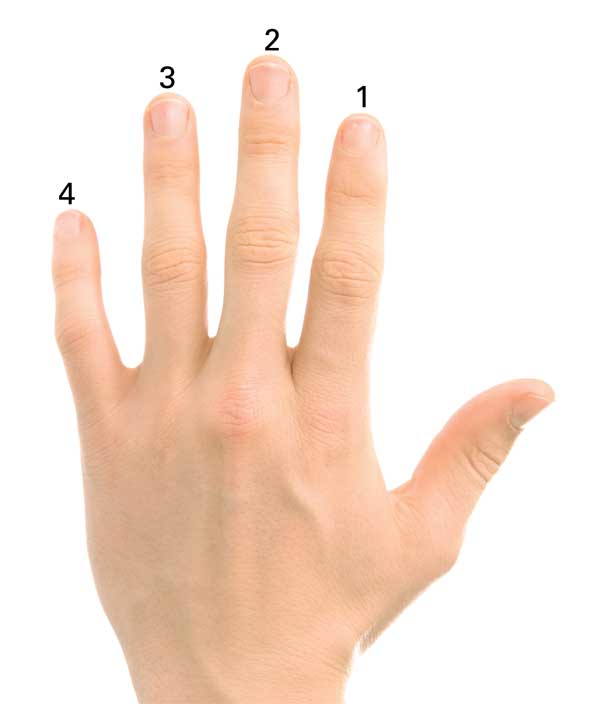
Picking the Strings
It is best to pick the strings with your fingernails as this gives a better sound. Grow your fingernails to a comfortable length for your playing with attention to the following points.

- The length of the nail should be approx. 2 – 3mm (3/32 – 5/32"). Generally the middle finger has the shortest nail and the ring finger the longest.
- The thumb nail should be longer than all three fingers.
- Fingernails should be shaped using a nail file (emery board) so that they have a rounded edge and flow smoothly off the string after it has been picked.
- Experiment with the overall shape of each nail.
Picking With the Fingers – The Free Stroke
The free stroke is the picking of a string with a right hand finger when the finger moves freely away from the string after it is picked. The finger picks the string then bends slightly into the palm of the hand. The finger will move across the adjacent string.

Position second finger to pick first string.

Second finger moves across second string after picking first string
Picking With the Thumb
The 6th, 5th, 4th and sometimes 3rd strings are picked with the thumb (p). In almost all cases a free stroke is used. After striking a string the thumb should move over the third string and return to its original position ready to strike again.
Your thumb should feel as if it is moving in small circles. Once again consider the two options for the position of the right hand thumb.
The classical position: The wrist is arched, thumb 45 degrees to the string and the thumbnail is used to pick the string.
The contemporary position: The wrist is kept close to the guitar face, the thumb almost parallel to the strings and the side of the thumb is used to strike the string.

Classical Position

Contemporary Position
Finger Names and Numbers
The left hand fingers are numbered as such.


The letters p, i, m and a are used to indicate the right hand fingers.
- p (pulgar) – thumb
- i (indicio) - index finger
- m (medio) – middle finger
- a (anular) – ring finger
First Position – Right Hand

The first position allocates the first finger(i) of the picking hand to the third string, the second finger(m) of the picking hand to the second string and the third finger(a) of the picking hand to the first string.
The thumb(p) will play the lower three strings. The adjacent photo highlights the first position of the right hand fingers (i), (m) and (a). These three fingers should be in position above the strings ready to pick.
Second Position – Right Hand

The second position allocates the first finger(i) of the picking hand to the fourth string, the second finger(m) of the picking hand to the third string and the third finger(a) of the picking hand to the second string.
The thumb(p) will play the lower two strings. The adjacent photo highlights the first position of the right hand fingers (i), (m) and (a). These three fingers should be in position above the strings ready to pick.
Bracing the Right Hand
Some fingerpickers prefer to use one of the following right hand bracing techniques. The first option involves resting the little finger of the right hand on the guitar face. The second ion involves resting the bottom of the hand on the bridge.

Rest little finger on guitar face.
